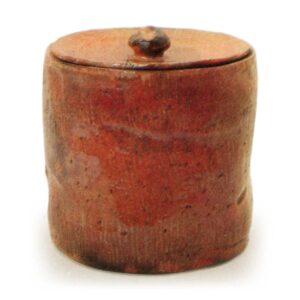
The ninth generation of the Raku family. In 1770, due to Tokuyu’s poor health, he succeeded to the family name and assumed the name of Kizen. In 1811, at the age of 56, he shaved his head and assumed the name Ryouiri, which was given to him by Ryōrōdasai Soza. From the age of 15 until the great fire in Kyoto in 1788 (Tenmei 8), his works are called “Mae-mae-gin” (前作) or “Hi-zen-gin” (火前印), and are highly valued because of the scarcity of surviving pieces. The works from then until 1811, when he was 56 years old, are called chu-in (middle seal), and the term soraku-in refers to the works of the last 23 years of his life, when he entered Buddhism and changed his name to Ryoiri. In 1819, when he was 63 years old, he and his second son, Tan’iru, worked together on the Kishu family’s Oniwa pottery. Many of his works are non-kou-bari, with skillful use of spatula and light weight, and the red glaze is extremely clear, especially in the black glaze, which is incomparably rich.
The Raku chu-in (seal) and Raku inka (seal flower) on the phoenix furnace favored by Ryōrōdasai were also made by Ryōirō, and it is said that the practice of sealing three or four seals on a single tea bowl, called Raku no ku-in (number seals), was also originated by Ryōirō. He died in September 1834 at the age of 79. (His works include “Chakka Sokko Kohan,” “Chado Sentei,” “Nihon Pottery Catalog,” “Kogei Kagami,” “Raku Ware,” and “Raku Potter’s Biography.)



